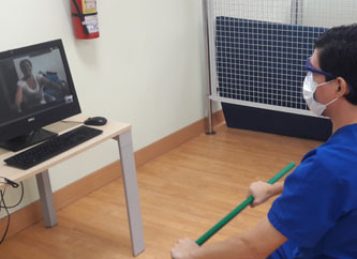Introduction:
Physical therapy plays a crucial role in promoting recovery, improving mobility, and enhancing the overall quality of life for individuals with various health conditions. Traditionally, physical therapy has been conducted in-person, requiring patients to visit clinics or rehabilitation centres. However, with advancements in technology, tele-rehabilitation has emerged as a promising solution, revolutionising the way physical therapy is delivered. In this blog post, we will explore the concept of tele-rehabilitation and discuss its potential benefits and implications for the future of physical therapy.
1. What is Tele-Rehabilitation?
Tele-rehabilitation refers to the use of technology, such as video conferencing, mobile applications, and wearable devices, to provide remote physical therapy services. It enables patients to receive therapy sessions from the comfort of their own homes, eliminating the need for frequent clinic visits. Through tele-rehabilitation, physical therapists can remotely assess patients, design personalised treatment plans, provide exercise instructions, monitor progress, and offer support and guidance throughout the rehabilitation process.
2.Advantages of Tele-Rehabilitation:
- Accessibility: Tele-rehabilitation breaks down geographical barriers, allowing individuals in remote areas or those with limited mobility to access high-quality physical therapy services. It ensures that patients receive timely care without the need for long-distance travel or transportation arrangements.
- Convenience and Flexibility: With tele-rehabilitation, patients have the flexibility to schedule therapy sessions at their convenience. It eliminates the need for commuting and waiting times, providing a more time-efficient approach to physical therapy. Patients can fit their sessions into their daily routines, enhancing adherence to treatment plans.
- Cost-Effectiveness: Tele-rehabilitation can significantly reduce healthcare costs for patients. By eliminating travel expenses and reducing the number of in-person visits, patients can save money on transportation, parking, and other associated costs. Additionally, tele-rehabilitation can help prevent hospital readmissions, resulting in further cost savings.
- Continuity of Care: Tele-rehabilitation promotes better continuity of care, especially for individuals with chronic conditions or long-term rehabilitation needs. Patients can maintain regular communication with their physical therapists, ensuring that their progress is continuously monitored and treatment plans are adjusted as needed.
3.Applications of Tele-Rehabilitation:
- Post-Surgical Rehabilitation: Tele-rehabilitation can effectively support post-surgical recovery by providing guidance on exercises, monitoring wound healing, and assessing range of motion. Physical therapists can remotely guide patients through each stage of the rehabilitation process, minimising complications and promoting faster recovery.
- Chronic Disease Management: Individuals with chronic conditions such as arthritis, Parkinson’s disease, or multiple sclerosis can benefit from tele-rehabilitation. Regular virtual sessions can help manage symptoms, improve mobility, and enhance overall functional capacity, thereby improving the patient’s quality of life.
- Geriatric Rehabilitation: Tele-rehabilitation holds great potential for elderly individuals who may face challenges in accessing traditional physical therapy services. It enables older adults to receive personalised care at home, reducing the risk of falls, improving balance and strength, and promoting independent living.
- Sports Injury Rehabilitation: Athletes and sports enthusiasts often require specialized rehabilitation after an injury. Tele-rehabilitation can provide access to expert physical therapists who can guide them through exercises, monitor their progress, and ensure a safe return to sports activities.
4. Considerations and Challenges:
- Technological Requirements: Tele-rehabilitation relies on a stable internet connection and appropriate technological devices such as smartphones, tablets, or computers. Ensuring that patients have access to these resources is essential for successful implementation.
- Privacy and Security: Protecting patient privacy and maintaining the security of sensitive health information is crucial in tele-rehabilitation. Adhering to data protection regulations and using secure communication platforms

